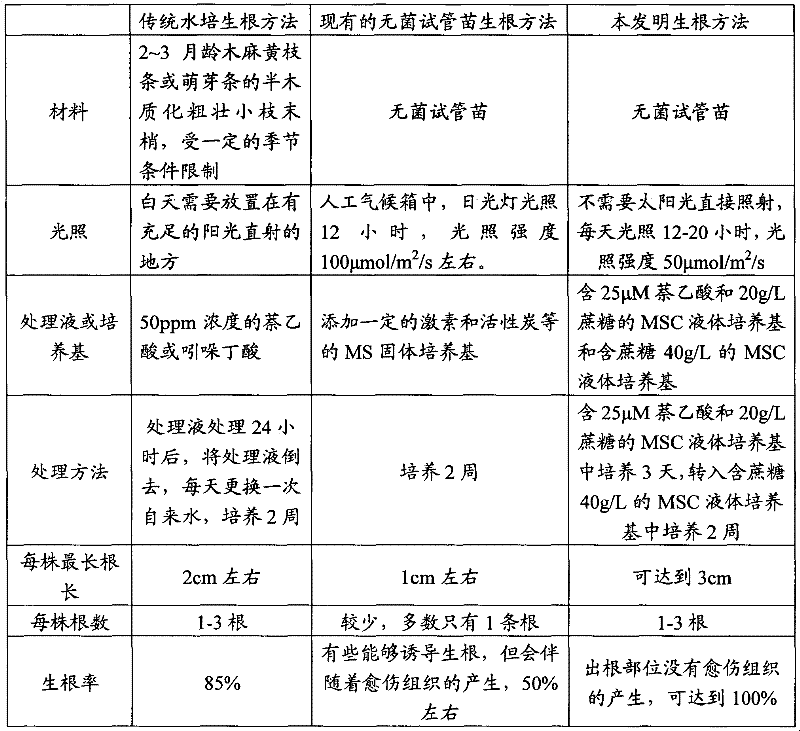Rooting method of casuarina equisetifolia sterile test-tube seedling
A test-tube seedling, casuarina japonica technology, applied in horticultural methods, botanical equipment and methods, plant regeneration, etc., can solve the problems of long time for inducing rooting, wound callus, low rooting rate, etc., and achieve root elongation and growth. The effect of obvious, broad development prospects and high rooting rate
- Summary
- Abstract
- Description
- Claims
- Application Information
AI Technical Summary
Problems solved by technology
Method used
Image
Examples
Embodiment 1
[0022] A rooting method of casuarina aseptic test-tube seedlings, the steps are as follows:
[0023] (1) MSC liquid medium (improved medium containing 1 / 2MS medium macroelements and 1 / 1MS medium trace elements, and vitamins of NN medium) containing 25μM naphthaleneacetic acid and 20g / L sucrose was prepared, with 0.1 Adjust the pH to 5.6 with M KOH.
[0024] The composition of MSC liquid medium is: NH 4 NO 3 825mg / L, KNO 3 950mg / L, CaCl 2 2H 2 O220mg / L, MgSO 4 ·7H 2 O 185mg / L, KH 2 PO 4 85mg / L, KI 0.83mg / L, H 3 BO 3 6.2mg / L, MnSO 4 4H 2 O 22.3mg / L, ZnSO 4 ·7H 2 O 8.6mg / L, Na 2 MoO 4 2H 2 O 0.25mg / L, CoCl 2 ·6H 2 O 0.025mg / L, CuSO 4 ·5H 2 O 0.025mg / L, Na 2 FeEDTA (FeSO 4 ·7H 2 O27.8mg / L, Na 2 EDTA·2H 2 O 37.3mg / L), biotin 0.05mg / L, folic acid 5mg / L, glycine 2mg / L, inositol 100mg / L, niacin 5mg / L, vitamin B60.05mg / L, vitamin B10.05mg / L.
[0025] (2) Put filter paper and cotton as a support at the bottom of the test tube (25×200mm), fill in 30ml of th...
Embodiment 2
[0032] Except containing 20 μ M naphthaleneacetic acid and 15g / L sucrose in the MSC liquid medium in step (1), except containing 35g / L sucrose in the MSC liquid medium of step (6), other operations are all identical with embodiment 1.
[0033] Adopt the condition of embodiment 2, done repeated test 5 times, each repeats and adopts 6 strains of sterile test-tube plantlets to test, the data after rooting is carried out statistical analysis, rooting rate is 92.5%, the average rooting number 1.72 of rooting seedlings, The average longest root length of rooted seedlings was 1.63 cm.
Embodiment 3
[0035]Except containing 30 μ M naphthaleneacetic acid and 25g / L sucrose in the MSC liquid medium in step (1), except containing 48g / L sucrose in the MSC liquid medium of step (6), other operations are all identical with embodiment 1.
[0036] Adopt the condition of embodiment 2, done repeated test 5 times, each repeats and adopts 6 strains of sterile test-tube plantlets to test, the data after rooting is carried out statistical analysis, rooting rate is 86.0%, the average rooting number 1.35 of rooting seedlings, The average longest root length of rooted seedlings was 3.12 cm.
PUM
 Login to View More
Login to View More Abstract
Description
Claims
Application Information
 Login to View More
Login to View More - R&D Engineer
- R&D Manager
- IP Professional
- Industry Leading Data Capabilities
- Powerful AI technology
- Patent DNA Extraction
Browse by: Latest US Patents, China's latest patents, Technical Efficacy Thesaurus, Application Domain, Technology Topic, Popular Technical Reports.
© 2024 PatSnap. All rights reserved.Legal|Privacy policy|Modern Slavery Act Transparency Statement|Sitemap|About US| Contact US: help@patsnap.com








